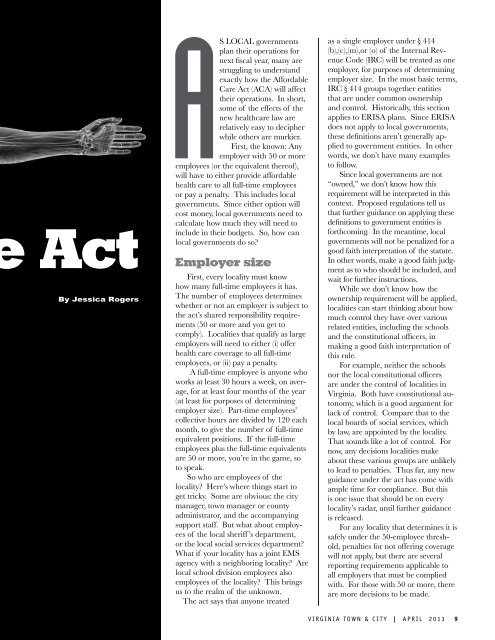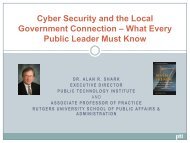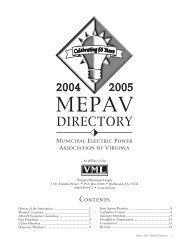Affordable Care Act - the Virginia Municipal League
Affordable Care Act - the Virginia Municipal League
Affordable Care Act - the Virginia Municipal League
You also want an ePaper? Increase the reach of your titles
YUMPU automatically turns print PDFs into web optimized ePapers that Google loves.
<strong>Act</strong>By Jessica RogersAs local governmentsplan <strong>the</strong>ir operations fornext fiscal year, many arestruggling to understandexactly how <strong>the</strong> <strong>Affordable</strong><strong>Care</strong> <strong>Act</strong> (ACA) will affect<strong>the</strong>ir operations. In short,some of <strong>the</strong> effects of <strong>the</strong>new healthcare law arerelatively easy to decipherwhile o<strong>the</strong>rs are murkier.First, <strong>the</strong> known: Anyemployer with 50 or moreemployees (or <strong>the</strong> equivalent <strong>the</strong>reof),will have to ei<strong>the</strong>r provide affordablehealth care to all full-time employeesor pay a penalty. This includes localgovernments. Since ei<strong>the</strong>r option willcost money, local governments need tocalculate how much <strong>the</strong>y will need toinclude in <strong>the</strong>ir budgets. So, how canlocal governments do so?Employer sizeFirst, every locality must knowhow many full-time employees it has.The number of employees determineswhe<strong>the</strong>r or not an employer is subject to<strong>the</strong> act’s shared responsibility requirements(50 or more and you get tocomply). Localities that qualify as largeemployers will need to ei<strong>the</strong>r (i) offerhealth care coverage to all full-timeemployees, or (ii) pay a penalty.A full-time employee is anyone whoworks at least 30 hours a week, on average,for at least four months of <strong>the</strong> year(at least for purposes of determiningemployer size). Part-time employees’collective hours are divided by 120 eachmonth, to give <strong>the</strong> number of full-timeequivalent positions. If <strong>the</strong> full-timeemployees plus <strong>the</strong> full-time equivalentsare 50 or more, you’re in <strong>the</strong> game, soto speak.So who are employees of <strong>the</strong>locality? Here’s where things start toget tricky. Some are obvious: <strong>the</strong> citymanager, town manager or countyadministrator, and <strong>the</strong> accompanyingsupport staff. But what about employeesof <strong>the</strong> local sheriff ’s department,or <strong>the</strong> local social services department?What if your locality has a joint EMSagency with a neighboring locality? Arelocal school division employees alsoemployees of <strong>the</strong> locality? This bringsus to <strong>the</strong> realm of <strong>the</strong> unknown.The act says that anyone treatedas a single employer under § 414(b),(c),(m),or (o) of <strong>the</strong> Internal RevenueCode (IRC) will be treated as oneemployer, for purposes of determiningemployer size. In <strong>the</strong> most basic terms,IRC § 414 groups toge<strong>the</strong>r entitiesthat are under common ownershipand control. Historically, this sectionapplies to ERISA plans. Since ERISAdoes not apply to local governments,<strong>the</strong>se definitions aren’t generally appliedto government entities. In o<strong>the</strong>rwords, we don’t have many examplesto follow.Since local governments are not“owned,” we don’t know how thisrequirement will be interpreted in thiscontext. Proposed regulations tell usthat fur<strong>the</strong>r guidance on applying <strong>the</strong>sedefinitions to government entities isforthcoming. In <strong>the</strong> meantime, localgovernments will not be penalized for agood faith interpretation of <strong>the</strong> statute.In o<strong>the</strong>r words, make a good faith judgmentas to who should be included, andwait for fur<strong>the</strong>r instructions.While we don’t know how <strong>the</strong>ownership requirement will be applied,localities can start thinking about howmuch control <strong>the</strong>y have over variousrelated entities, including <strong>the</strong> schoolsand <strong>the</strong> constitutional officers, inmaking a good faith interpretation ofthis rule.For example, nei<strong>the</strong>r <strong>the</strong> schoolsnor <strong>the</strong> local constitutional officersare under <strong>the</strong> control of localities in<strong>Virginia</strong>. Both have constitutional autonomy,which is a good argument forlack of control. Compare that to <strong>the</strong>local boards of social services, whichby law, are appointed by <strong>the</strong> locality.That sounds like a lot of control. Fornow, any decisions localities makeabout <strong>the</strong>se various groups are unlikelyto lead to penalties. Thus far, any newguidance under <strong>the</strong> act has come withample time for compliance. But thisis one issue that should be on everylocality’s radar, until fur<strong>the</strong>r guidanceis released.For any locality that determines it issafely under <strong>the</strong> 50-employee threshold,penalties for not offering coveragewill not apply, but <strong>the</strong>re are severalreporting requirements applicable toall employers that must be compliedwith. For those with 50 or more, <strong>the</strong>reare more decisions to be made.<strong>Virginia</strong> Town & City | april 2013 9









